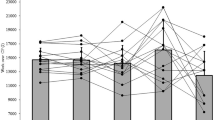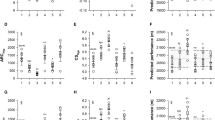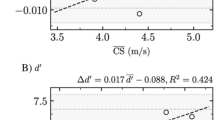Abstract
When facing a long-distance race, athletes and practitioners could develop an efficient pacing strategy and training paces if an accurate performance estimate of the target distance is achieved. Therefore, this study aims to determine the validity of different empirical models (i.e. critical power [CP], Power law and Peronnet) to predict long-duration power output (i.e. 60 min) when using two or three time trial configurations. In a 5-week training period, fifteen highly trained athletes performed nine-time trials (i.e. 1, 2, 3, 4, 5, 10, 20, 30, and 60 min) in a randomized order. Their power-duration curves were defined through the work-time (CPwork), power-1/time (CP1/time), two-parameter hyperbolic (CP2hyp), three-parameter hyperbolic (CP3hyp) CP models using different two- and three–time trial configurations. The undisclosed proprietary CP models of the Stryd (CPstryd) and Golden Cheetah training software (CPcheetah) were also computed as well as the non-asymptotic Power law and Peronnet models. These were extrapolated to the 60-min power output and compared to the actual performance. The shortest valid configuration (95% confidence interval < 12 W) for CPwork and CP1/time was 3–30 min (Bias: 8.3 [4.9 to 11.7] W), for CPstryd was 10–30 min (Bias: 4.2 [− 1.0 to 9.4] W), for CP2hyp, CP3hyp and CPcheetah was 3-5-30 min (Bias < 5.7 W), for Power law was 1-3-10 min (− 1.0 [− 11.9 to 9.9] W), and for Peronnet was 4–20 min (− 3.0 [− 10.2 to 4.3] W). All the empirical models provided valid estimates when the two or three predicting trial configurations selected attended each model fitting needs.



Similar content being viewed by others
Data availability
The data supporting the findings are not publicly available. Any raw data would be shared upon reasonable request from the corresponding author.
References
Abbiss CR, Laursen PB (2008) Describing and understanding pacing strategies during athletic competition. Sports Med 38:239–252
Allen H, Coggan AR, McGregor S (2019) Training and racing with a power meter. VeloPress, Boulder
Bishop D, Jenkins DG, Howard A (1998) The critical power function is dependent on the duration of the predictive exercise tests chosen. Int J Sports Med 19(02):125–129
Bland JM, Altman D (1986) Statistical methods for assessing agreement between two methods of clinical measurement. Lancet 327(8476):307–310
Cerezuela-Espejo V, Hernández-Belmonte A, Courel-Ibáñez J, Conesa-Ros E, Mora-Rodríguez R, Pallarés JG (2021) Are we ready to measure running power? Repeatability and concurrent validity of five commercial technologies. Eur J Sport Sci 21(3):341–350
Coquart JB, Bosquet L (2010) Precision in the prediction of middle distance-running performances using either a nomogram or the modeling of the distance-time relationship. J Strength Cond Res 24(11):2920–2926
Coquart JB, Alberty M, Bosquet L (2009) Validity of a nomogram to predict long distance running performance. J Strength Cond Res 23(7):2119–2123
Dearing CG, Paton CD (2022) Is stryd critical power a meaningful parameter for runners? Biol Sport 40(3):657–664
Foster C, de Koning JJ, Hettinga FJ, Barroso R, Boullosa D, Casado A, van Tunen J (2023) Competition between desired competitive result, tolerable homeostatic disturbance, and psychophysiological interpretation determines pacing strategy. Int J Sports Physiol Perform 18:1–12
Gamelin FX, Coquart J, Ferrari N, Vodougnon H, Matran R, Leger L, Bosquet L (2006) Prediction of one-hour running performance using constant duration tests. J Strength Cond Res 20(4):735–739
García-Pinillos F, Latorre-Román PÁ, Roche-Seruendo LE, García-Ramos A (2019) Prediction of power output at different running velocities through the two-point method with the Stryd™ power meter. Gait Posture 68:238–243
Girardi M, Gattoni C, Sponza L, Marcora SM, Micklewright D (2022) Performance prediction, pacing profile and running pattern of elite 1-h track running events. Sport Sci Health. https://doi.org/10.1007/s11332-022-00945-w
Gorostiaga EM, Sánchez-Medina L, Garcia-Tabar I (2022) Over 55 years of critical power: fact or artifact? Scand J Med Sci Sports 32(1):116–124
Hill AV (1927) Muscular movement in man: the factors governing speed and recovery from fatigue, vol 3. McGraw-Hill book comapny, New York
Hill DW (1993) The critical power concept: a review. Sports Med 16:237–254
Hugh Morton R (1996) A 3-parameter critical power model. Ergonomics 39(4):611–619
Imbach F, Candau R, Chailan R, Perrey S (2020) Validity of the Stryd power meter in measuring running parameters at submaximal speeds. Sports 8(7):103
Jones AM, Vanhatalo A, Burnley M, Morton RH, Poole DC (2010) Critical power: implications for determination of VO2max and exercise tolerance. Med Sci Sports Exerc 42(10):1876–1890
Kennelly AE (1906) An approximate law of fatigue in the speeds of racing animals. Proc Am Acad Arts Sci 42(15):275–331
Lerebourg L, Guignard B, Racil G, Jlid MC, Held E, Coquart JB (2022) Prediction of distance running performances of female runners using nomograms. Int J Sports Med 43(09):773–782
Liversedge, M. (2023a). Critical Power model Fitting . Golden Cheetah. https://www.goldencheetah.org/#section-tutorials
Liversedge, M. (2023b) GoldenCheetah. https://www.goldencheetah.org/.
Ludbrook J (2002) Statistical techniques for comparing measurers and methods of measurement: a critical review. Clin Exp Pharmacol Physiol 29(7):527–536
Ludbrook J (2010) Linear regression analysis for comparing two measurers or methods of measurement: but which regression? Clin Exp Pharmacol Physiol 37(7):692–699
Lundby C, Robach P (2015) Performance enhancement: what are the physiological limits? Physiology 30:282–292
McKay AK, Stellingwerff T, Smith ES, Martin DT, Mujika I, Goosey-Tolfrey VL, Burke LM (2021) Defining training and performance caliber: a participant classification framework. Int J Sports Physiol Perform 17(2):317–331
Moritani T, Nagata A, Devries HA, Muro M (1981) Critical power as a measure of physical work capacity and anaerobic threshold. Ergonomics 24(5):339–350
Morton RH (2006) The critical power and related whole-body bioenergetic models. Eur J Appl Physiol 96(4):339–354
Noakes TD (2011) Time to move beyond a brainless exercise physiology: the evidence for complex regulation of human exercise performance. Appl Physiol Nutr Metab 36(1):23–35
Péronnet F, Thibault G (1989) Mathematical analysis of running performance and world running records. J Appl Physiol 67(1):453–465
Poole DC, Burnley M, Vanhatalo A, Rossiter HB, Jones AM (2016) Critical power: an important fatigue threshold in exercise physiology. Med Sci Sports Exerc 48(11):2320
Purdy JG (1975) Computer generated track and field scoring tables: II. Theoretical foundation and development of a model. Med Sci Sports 7(2):111–115
Ruiz-Alias SA, Olaya-Cuartero J, Ñancupil-Andrade AA, García-Pinillos F (2022) 9/3-minute running critical power test: mechanical threshold location with respect to ventilatory thresholds and maximum oxygen uptake. Int J Sports Physiol Perform 17:1–8
Ruiz-Alias, S.A., Ñacupil-Andrade, A., Pérez-Castilla, A., García-Pinillos, F. (2023a). Determination of Running Critical Power and W´ through Two-time Trials (Manuscript submitted).
Ruiz-Alias, S.A., Ñacupil-Andrade, A., Pérez-Castilla, A., García-Pinillos, F. Can we predict long-durations running power output? (2023b) Validity of the critical power, power law and logarithmic models. J Strength Cond Res
Ruiz-Alias, S.A., Ñacupil-Andrade, A., Pérez-Castilla, A., García-Pinillos, F (2023c) Critical Power in Endurance Runners: A Comparison of the Estimated Parameters Reported by Different Theoretical Models. Int J Sports Med
Spiriev, B. and Spiriev, A (2022) Scoring tables of athletics. World Athletics.
Stryd. (2023) Stryd Powercenter. https://www.stryd.com/powercenter/.
Taboga P, Giovanelli N, Spinazzè E, Cuzzolin F, Fedele G, Zanuso S, Lazzer S (2022) Running power: lab based vs. portable devices measurements and its relationship with aerobic power. Eur J Sport Sci 22(10):1555–1568
Vandewalle H (2018) Modelling of running performances: comparisons of power-law, hyperbolic, logarithmic, and exponential models in elite endurance runners. BioMed Res Int 2018:1–23
Whipp BJ, Huntsman DJ, Storer TW, Lamarra N, Wasserman K (1982) A constant which determines the duration of tolerance to high-intensity work. Fed Am Soc Exp Biol 41(5):1591
Zinoubi B, Vandewalle H, Driss T (2017) Modeling of running performances in humans: comparison of power laws and critical speed. J Strength Cond Res 31(7):1859–1867
Acknowledgements
This study is part of a PhD thesis conducted in the Biomedicine Doctoral Studies of the University of Granada, Spain.
Funding
The funding was provided by Ministerio de Universidades, FPU19/00542, Santiago Alejo Ruiz Alias. This project was supported by the Andalusian Sports Institute (Instituto Andaluz del Deporte, ref. 5562) in addition to the Ministerio de Universidades (FPU19/00542) that only belongs to Santiago A. Ruiz-Alias.
Author information
Authors and Affiliations
Contributions
SARA, AAÑA, APC and FGP were involved in the concept design, data collection, manuscript preparation and final approval.
Corresponding author
Ethics declarations
Conflict of interest
The authors declare that they have no conflict of interest.
Additional information
Communicated by Michael I Lindinger.
Publisher's Note
Springer Nature remains neutral with regard to jurisdictional claims in published maps and institutional affiliations.
Rights and permissions
Springer Nature or its licensor (e.g. a society or other partner) holds exclusive rights to this article under a publishing agreement with the author(s) or other rightsholder(s); author self-archiving of the accepted manuscript version of this article is solely governed by the terms of such publishing agreement and applicable law.
About this article
Cite this article
Ruiz-Alias, S.A., Ñancupil-Andrade, A.A., Pérez-Castilla, A. et al. Can we predict long-duration running power output? A matter of selecting the appropriate predicting trials and empirical model. Eur J Appl Physiol 123, 2283–2294 (2023). https://doi.org/10.1007/s00421-023-05243-y
Received:
Accepted:
Published:
Issue Date:
DOI: https://doi.org/10.1007/s00421-023-05243-y




